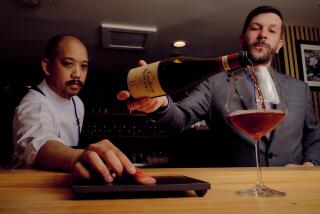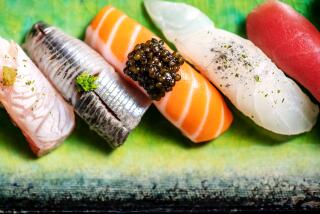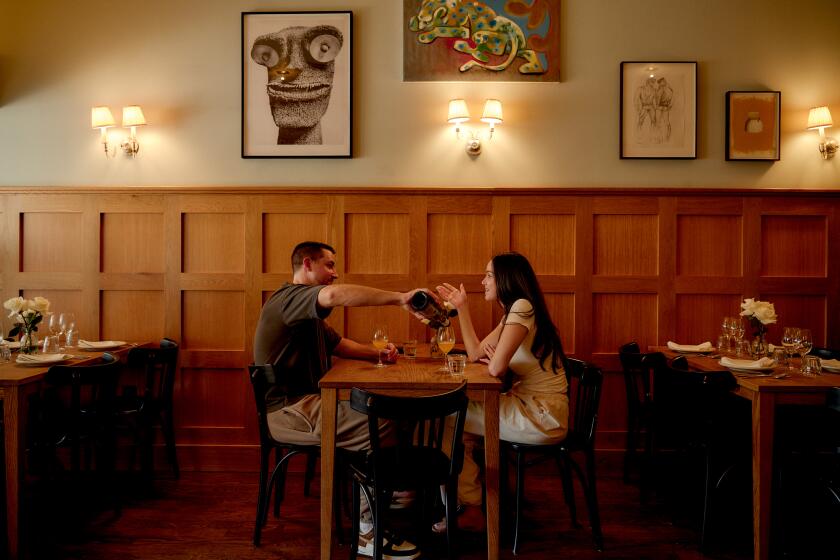The Nouveaux of November
Listen. Is that the faint roll of drumbeats in the distance? Is it getting louder? Yes, it’s the nation’s wine sellers beginning to raise the annual din over the year’s Beaujolais nouveau. By Nov. 20, when the wine makes its debut, the noise will be deafening.
Beaujolais nouveau used to be a local phenomenon, confined to the Beaujolais region of France and the bars and bistros of Lyon and Paris. Now this newly vinified, intensely fruity red, which finished fermenting just a few weeks ago, is an international celebrity, swooping in by jetliner on and after the third Thursday of November.
Most serious wine people look at nouveau wines with a jaded eye. Indeed, Beaujolais nouveau is hardly something that deserves much discussion. There’s nothing wrong with it, but it’s not a very interesting wine, and it has a short shelf life, losing its in-your-face charm within about six months.
The wine is made by carbonic maceration, a technique of blanketing grape clusters with carbon dioxide so that fermentation begins within the berries. In contrast to grapes for regular Beaujolais, they are pressed quickly after fermentation lest the must extracts too much tannin and flavoring from the grape skins. The result is a fresh, grapy, purple quaff that is usually delicious, if simple.
Still, there’s some reason to pay attention to the Beaujolais nouveau this season, because the grapes were of superior quality. After a warm, dry summer, the 1997 Beaujolais harvest began astonishingly early, on Aug. 30; the previous record was Aug. 31, 1976, while the average for the last 17 years has been Sept. 12. The producers describe the wines as ronde, gras and voluptueux (round, fat and voluptuous).
The upside of all the hoopla surrounding the debut of this year’s nouveau wines is that it draws attention to light, fruity reds, a category that’s ideal for November in Southern California, where daytime high temperatures average in the mid-60s. I might add that this style of wine is a perfect companion to roast turkey and its traditional Thanksgiving accompaniment, cranberry sauce.
There are many fruity reds that share Beaujolais nouveau’s appealing qualities while offering more flavor interest. First to come to mind is “real” (non-nouveau) Beaujolais from the very good 1996 or 1995 vintages. The ’95 Beaujolais were generally quite ripe, full-bodied wines and are holding up nicely. The ’96 wines are generally a bit lighter and more acidic. (Incidentally, all but the sturdiest Beaujolais should be drunk at cool cellar temperature, not room temperature. An hour in the refrigerator before serving is usually perfect.)
The very reliable names of Georges Duboeuf and Louis Jadot dominate the Beaujolais category in this country, but to really see the heights to which Beaujolais can aspire, try the 1996 Co^te de Brouilly “Cuvee Vieilles Vignes Reserve” from Georges Viornery, imported by the North Berkeley Wine Co.
Co^te de Brouilly is one of the 10 Beaujolais crus, the villages that have their own distinctive appellations controlees within the Beaujolais-Villages region. Seldom seen in this country, it encompasses the best vineyard areas on the slopes of Mont Brouilly at the heart of the much better-known Brouilly appellation, whose boundaries extend widely (and, critics would say, too generously) across an area of varying soils and exposures.
In other words, if you like Brouilly, you’ll love Co^te de Brouilly. And Viornery selected this one from its oldest and highest-quality vineyard area, with vines ranging in age from 65 to 100 years.
The importer is a proponent of unfiltered wines, and it is readily apparent that this wine did not undergo the typical filtration; it lacks that bright, glistening transparency we’re accustomed to in commercial Beaujolais. But what it may lack in clarity it makes up for in flavor (North Berkeley’s David Hinkle would argue that that’s no coincidence), with a beguiling aroma of strawberries in the nose and lush fruit on the palate, backed by decent tannins. With a little airing, it develops complex nuances of spices, woodsiness and leather.
At about $15 to $17, this wine costs roughly twice what Beaujolais-Villages goes for, and do you know what? You get what you pay for.
Simpler and more direct in style is a California bottling, 1996 Preston Vineyards Gamay Beaujolais (Dry Creek Valley, about $9). I have long been a fan of Lou Preston’s myriad wines, and the annual appearance of the winery’s freshly bottled Gamay in mid-November is like a reunion with an old friend.
Preston’s Gamay plantings date from the winery’s founding in the 1970s. At the time, the rationale for planting Gamay wasn’t based on market research but on hearsay; other longtime Dry Creek Valley farmers said that the grape did well on the soils in a certain small section of Preston’s 110 acres.
The 1997 Preston Gamay will start to show up around town this week, just before the French nouveau arrives, but the 1996 bottling is still available and still deserving of attention.
Kevin Hamel, Preston’s winemaker, says the 1996 vintage produced an unusually small crop of Gamay, and the resulting wine has atypical concentration. A year after release, the wine is perfumed with the aroma of crushed fresh raspberries, and its soft fruitiness is tempered by herbal notes and some tannin. It may taste as if it were made by carbonic maceration, but it was conventionally vinified, though fermented at a cool temperature with yeasts that accent fruitiness.
Italy produces nouveau wines too. With so much attention being paid to its 1997 vintage--producer after producer has dubbed it “the vintage of the century”--the arrival of the novelli, such as Cavit’s Teroldego and Zenato’s Bardolino, is more highly anticipated than usual.
But for a combination of juicy, nouveau-style fruit with the flesh and flavors of Piedmont, check out the 1996 Barbera d’Asti from Cascina Castlet ($10, exclusively at Wine Expo, Santa Monica). This wine is effusively fruity, with attractive black cherry aromas and juicy, crisp flavors accented by an appealing gamy quality.
All right, I’ll admit it. You’ll never mistake 1995 Cline Zinfandel (California, about $10) for a nouveau bottling. This wine, from a Sonoma-based winery that specializes in Rhone varietals and blends, is more evolved than nouveau, and at 13.5% alcohol, it’s hardly light-bodied. But for my money, this lower tannin, fruity Zin has enormous appeal. It was produced from old-vine Zinfandel vineyards in Contra Costa County and elsewhere in the state, each lot of wine handled separately until selection and blending into the final cuvee. The result is a well-balanced, ripe-textured wine laden with aromas of crushed red fruit, coffee and brown sugar, backed up by firm acidity that cries out for food. This is a wine of incredible versatility; it should be on every wine list in Southern California.
Speaking of this: I wish I ran into more of these food-friendly and inexpensive wines on restaurant wine lists. Light, fruity reds pair beautifully with the kind of bistro, trattoria and ethnic foods we crave: roast chicken, tea-smoked duck, seared ahi, thin-crust pizza, pot stickers--I could go on and on.
Because their lower tannin levels, crisp fruit and fresh, direct flavor make them versatile foils for a variety of foods, they’re ideal wines to order for a table at which everyone’s eating a different dish.
Barrett is a Los Angeles-based writer who contributes to Wine Spectator, Cigar Aficionado, Westways and Buzz.
More to Read
Eat your way across L.A.
Get our weekly Tasting Notes newsletter for reviews, news and more.
You may occasionally receive promotional content from the Los Angeles Times.










